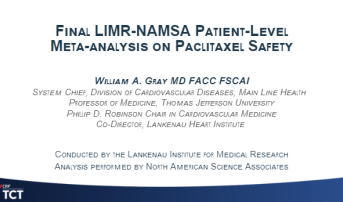Paclitaxel Safety Questions in PAD: Will ‘Capstone’ Data Close the Door?
(UPDATED) After nearly 5 years, most at a TCT 2023 session agreed that the mystery of the paclitaxel signal has been solved.

SAN FRANCISCO, CA—A patient-level, pooled meta-analysis of trials looking at paclitaxel-coated versus uncoated devices in peripheral vascular interventions (PVIs), with median follow-up out to 4.9 years, shows no evidence of an increased risk of death, once again refuting suggestions that paclitaxel is associated with a mortality effect.
Those concerns stemmed from the 2018, summary-level meta-analysis of 28 femoropopliteal disease RCTs. It showed a late mortality signal beginning at 2 to 3 years in patients with PAD treated with a paclitaxel-based drug-eluting stent or drug-coated balloon (DCB) compared with a plain balloon or plain stent, with a 7% estimation of increased absolute risk at 4-5 years.
In July 2023, the US Food and Drug Administration reversed the restrictions it had placed on the use of paclitaxel-based therapies in PVIs as a result of the 2018 study, saying that the decision was based on their “review of the totality of the available data and analyses.” But the agency noted in their letter to healthcare providers that a “updated RCT meta-analysis does not indicate that the use of paclitaxel-coated devices is associated with a late mortality risk.”
That updated meta-analysis, previously only seen by the FDA’s reviewers, was presented here in a special session at TCT 2023 and published simultaneously in the Lancet. It shows no significant increase in death in patients treated with paclitaxel-coated devices in intention-to-treat (ITT), as-treated, and two crossover analyses.
“Until this particular analysis was done, it was really difficult to say that the case was closed,” senior author William A. Gray, MD (Main Line Health/Lankenau Heart Institute, Wynnewood, PA), told TCTMD. “So, I think when you look at the totality of the data that has been collected and analyzed over more than 4 years, this is the capstone.”
Until this particular analysis was done, it was really difficult to say that the case was closed. William A. Gray
The analysis of long-term mortality in 2,666 patients follows multiple other efforts that have shown no evidence to support a mortality signal, including real-world Medicare analyses, long-term data sets from Germany, Italy, and Japan, an individual patient-level meta-analysis conducted by VIVA that pieced together missing data from pivotal trials, and the ongoing, long-term SAFE-PAD study conducted in conjunction with the FDA.
Commenting for TCTMD, Venita R. Chandra, MD (Stanford University Medical Center, CA), said she agreed with Gray that this meta-analysis hopefully represents the final word on the paclitaxel controversy.
“I feel like it's a breath of fresh air to just finally, pretty confidently, have touched everyone's concerns and elegantly addressed the deficiencies of prior work,” she said. “This is, I think, the final straw on the camel's back of good work to take this controversy away and let us focus on other things.”
Patient-Level Data Recovery
Led by Sahil Parikh, MD (NewYork-Presbyterian/Columbia University Irving Medical Center, New York, NY), the meta-analysis included 10 trials: ILLUMENATE, ILLUMENATE EU, IN.PACT SFA I/II, IN.PACT SFA Japan, LEVANT I and II, LEVANT Japan, Zilver PTX, RANGER SFA, and RANGER II SFA. For each of the trials, the researchers worked with device manufacturers to obtain deidentified patient-level data for analysis. The FDA was involved, as well, approving analysis elements, design, and methodology.
Five-year follow-up was available for 95% of evaluable patients, which adds 3,300 person-years of follow-up since the 2020 patient-level meta-analysis.
In the ITT analysis, which used the original randomization assignment for each trial based on ITT, the overall hazard ratio (HR) for risk of death with paclitaxel-coated devices versus uncoated control was 1.14 (95% CI 0.93-1.40). The result was nearly identical in the as-treated analysis, which included any participants exposed to paclitaxel at the index procedure: HR 1.13 (95% CI 0.92-1.39).
The as-treated crossover analyses, censoring late crossovers, also did not show a difference between the paclitaxel-coated and control groups (HR 1.07; 95% CI 0.87-1.31), nor did a time-varying analysis of late crossovers in which paclitaxel exposure was considered from date of exposure (HR 1.04; 95% CI 0.84-1.28).
This is, I think, the final straw on the camel's back of good work to take this controversy away and let us focus on other things. Venita R. Chandra
Approximately 20 baseline covariates were examined, ranging from age, sex, and race to comorbidities, lesion count, and calendar year of randomization. None of the covariates were found to be associated with increased paclitaxel-coated device hazard ratio for all-cause death.
To further analyze for outcome possibilities by dose, the investigators evaluated risk of death according to paclitaxel dose tertiles (low, medium, and high). Again, there was no increased risk compared with placebo. Dose also was analyzed as a continuous measure to look at its association with risk of death, again with no differences.
Gray noted that the study uncovered a finding that has not previously been seen amid the myriad of paclitaxel data-wrangling.
In a post-hoc analysis of lesion length and mortality, increased death was seen in the control group in those with longer lesion length, with a HR of 1.24 (95% CI 0.67-2.28) when comparing the medium lesion length group with the shortest lesion length group, and a HR of 1.47 (95% CI 0.96-2.27) when comparing the longest lesion length group with the shortest (P = 0.12 for homogeneity).
“It sort of makes sense because it’s a surrogate for burden of disease,” Parikh said. “So the more atherosclerosis that the patient has, the higher their risk for mortality, probably from atherothrombotic events. That actually hasn't really been shown before because they weren't able to get the quantitative patient-level measurements in the summary analysis.”
While the analysis appears to be the most comprehensive patient-level thus far attempting to reconcile the problems uncovered by the 2018 meta-analysis, Parikh and colleagues note that it is not without some criticisms, including the fact that the recovered data don’t account for 5% of the trial patients, which they say “is still a potential concern but reflects consistently better long-term follow-up rates compared with other peripheral artery disease trials to date.” The patient-level meta-analysis also assumes that all paclitaxel-coated devices behave similarly, with a class effect for safety, although the researchers acknowledge that “it is widely held that the same cannot be said for effectiveness.”
The Question of Low-Dose Influence
Konstantinos Katsanos, MD, PhD (Patras University Hospital, Rion, Greece), who authored the 2018 meta-analysis that kickstarted the controversy, told TCTMD that while the statistical analysis is robust and the study provides a more complete vital status update for most of the cases across the pivotal RCTs, it “falls short” of addressing the concerns surrounding paclitaxel-coated balloons and stents in the femoropopliteal segment.
“If one compares the studies included in our original JAHA meta-analysis compared to the ones in the June 2020 Circulation paper, and further in the current Lancet paper, it is obvious that the critical significance of the paclitaxel mortality signal has been diluted by the inclusion of large, low-dose RCTs that clearly dominate the Lancet paper,” Katsanos said in an email.
“In the subgroup analyses of our original paper we clearly documented that low-dose 2.0 μg/mm2 paclitaxel balloons were associated with a nonsignificant mortality difference (RR 1.27; 95% CI 0.70-2.32 at 2 years) and showed that the long-term signal was mainly driven by the ZILVER-PTX and IN.PACT SFA randomized trials,” Katsanos added. “Suppose we take out all the low-dose trials from the latest Lancet paper (there was none in our original JAHA paper with 5-year follow-up), then you may easily compute a highly significant mortality risk with a HR of 1.38 (95% CI 1.19-1.60; P < 0.0001) at 5 years.”
To TCTMD, Parikh said the problem with that explanation is that the dose on the balloon is a surrogate for dose, rather than the true amount that is absorbed.
“Also, this way of thinking doesn’t account for lesion length and, from what we saw [in the meta-analysis], the ZILVER data didn’t account for crossovers in the intention-to-treat analysis,” he added. “Considering dose alone on the balloon or stent is an oversimplified approach. I don’t think there is any plausible signal. Our data have been published and peer-reviewed by statisticians at the FDA, which I think speaks for itself.”
More Lessons Learned
Parikh and colleagues say if there is one lesson to be taken from the last nearly 5 years of trying to parse the messages in the original meta-analysis, it’s that “clinical trials should completely follow patients for longer, and vital status assessments might need to be done with conjoined national registries, such as the US Medicare Death Index.”
To TCTMD, Gray added that one overarching lesson is that summary-level data should be taken with a grain of salt.
“Incomplete data is likely to lead to type one errors, finding a result which may actually not exist,” he said. “We have to do our studies better, especially from a statistic standpoint. We have to be collecting [patient-level] data in both arms of device trials so we don’t end up with missing data and endless questions.”
Similarly, Peter Schneider, MD (University of California, San Francisco), another co-author on the analysis today, told TCTMD that in retrospect, the initial analysis should have been considered a hypothesis-generating tool.
“But of course everybody responds substantially to a mortality signal: how could you not?” Schneider noted.
Responding to a comment made by Elazer R. Edelman, MD, PhD (Massachusetts Institute Of Technology/Brigham and Women’s Hospital, Boston), during the session that lower-quality studies in PAD, leading to outsized reactions to mathematical signals, are doomed to be repeated if lessons aren’t learned, Schneider said he isn’t as pessimistic.
“I think . . . we’re going to now look with the same rigor in these PAD trials as we look for in a coronary trial. I think this is a good message,” he said. That, in his opinion, is the silver lining in this long-running controversy.
“A lot of good came out of it,” he said, including “ideas about how to make better trials, better designs for trials going forward, that all makes sense.” But, he notes, “there was some negative that came out of it, too. That is that for the past 4 and a half years, patients very often were denied the most efficacious treatment we have for fem-pop disease.”
Weighing in on the regulatory perspective, Eleni Whatley, PhD (Peripheral Interventional Devices Branch, FDA), said the mortality signal was “real” at the time and was confirmed by the FDA’s own analysis and by others. “This was a long process,” she noted, “but it really needed to be done to make sure that these devices were safe for patient use.”
Whatley added that the resolution of the signal came from a multi-stakeholder collaboration. “I don’t think anyone could have done it alone,” she said.
Juan Granada, MD (Cardiovascular Research Foundation, New York, NY), a panelist in today’s session, observed that this entire experience has brought to the fore the importance of a rapid response force to address these kinds of issues quickly.
“Despite the fact that we had a lot of data to try to understand the mechanism of action . . . we all put in a lot of work and tried to move as fast as we could, but it took 5 years . . . and that speaks volumes about the importance of developing networks that can work quickly and answer these questions that not only slow down technology development, but also prevent the use of vital technologies,” he said.
L.A. McKeown is a Senior Medical Journalist for TCTMD, the Section Editor of CV Team Forum, and Senior Medical…
Read Full BioSources
Parikh SA, Schneider PA, Mullin CM, et al. Mortality in randomised controlled trials using paclitaxel-coated devices for femoropopliteal interventional procedures: an updated patient-level meta-analysis. Lancet. 2023;Epub ahead of print.
Disclosures
- Parikh reports serving on advisory boards for Abbott Vascular, Boston Scientific, Cordis, Medtronic, and Philips; receiving institutional research funding from Abbott Vascular, Boston Scientific, Surmodics, TriReme Medical, Shockwave Medical, Reflow Medical, Acotec and Concept Medical; consulting for Terumo, Inari, Penumbra and Canon; and having equity in Advanced Nanotherapies, eFemoral, and Encompass Vascular.
- Gray reports consulting for Philips, Medtronic, Boston Scientific, Surmodics, Encompass Vascular, eFemoral, Cagent, Sonovascular, Conformal Medical, Contego Medical, ReValve, Alucent, and Edwards Lifesciences; and holding stock with eFemoral, Encompass Vascular, Xenter, and Reflow Medical.
- Schneider reports consultant fee/honoraria/speaker's Bureau for Medtronic; Boston Scientific Corporation; Philips; and Abbott.






Comments